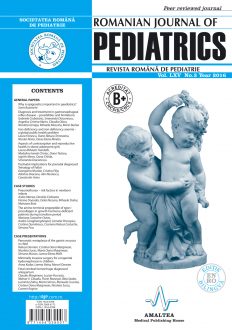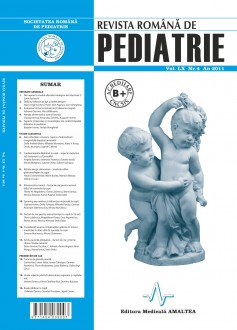SELECT ISSUE

Indexed

| |

|
|
|
| |
|
|
|

|
|
|
|
|
|
|
HIGHLIGHTS
National Awards “Science and Research”
NEW! RJP has announced the annually National Award for "Science and Research" for the best scientific articles published throughout the year in the official journal.
Read the Recommendations for the Conduct, Reporting, Editing, and Publication of Scholarly work in Medical Journals.
The published medical research literature is a global public good. Medical journal editors have a social responsibility to promote global health by publishing, whenever possible, research that furthers health worldwide.
PROPEPTIDUL AMINO-TERMINAL AL PROCOLAGENULUI TIP I LA PACIENTII CU DEFICIT DE HORMON DE CRESTERE IN PERIOADA DE TRANZITIE
Andra Caragheorgheopol, Camelia Procopiuc, Cosmina Raluca Costache, Cristina Dumitrescu, Mariana Costache-Outas and Simona Fica
REZUMAT
Introducere. Achiziţia de masă osoasă continuă şi după atingerea taliei finale în perioada de tranziţie. Deficitul de hormon de creştere (GHD) pare să aibă un efect semnificativ asupra turnover-ului colagenului în timpul copilăriei şi mai puţin în timpul maturităţii. Propeptidul amino terminal al colagenului tip I (P1NP) este un marker de formare osoasă cu variabilitate intraindividuală scăzută faţă de IGF1.
Subiecţi şi metodă. 17 pacienţi de sex masculin diagnosticaţi în timpul copilăriei cu GHD, retestaţi în perioada de tranziţie, au fost evaluaţi la minimum 3 luni de la întreruperea tratamentului cu GH. Am evaluat corelaţia P1NP cu IGF1. Am determinat puterea predictivă a P1NP în identificarea pacienţilor cu deficit de GH persistent.
Rezultate. Am găsit o corelaţie pozitivă puternică între P1NP şi IGF-1 în grupul de pacienţi care au menţinut deficitul de GH în perioada de adult tânăr (r = 0,72, CI [0,02 la 0,94], p = 0,046). O valoare prag pentru P1NP de - 0,66 SDS prezice persistenţa deficitului de GH cu o sensibilitate de 62,5% CI [24,5 la 91,5], specificitate de 75% CI [47,6 la 92,7] şi AUC = 0,719 CI [0,5 la 0,881], p<0,05. Nu am găsit o diferenţă semnificativă atunci când am comparat AUC pentru cei 2 parametri (p = 0.29).
Concluzii. În perioada de tranziţie, atunci când viteza de creştere nu mai este disponibilă, dinamica P1NP în timpul terapiei substitutive cu GH ar putea fi utilă în cuantificarea eficienţei tratamentului.
Cuvinte cheie: Markeri de colagen, P1NP, IGF1, hormon de creştere, deficit de GH, perioada de tranziţie

